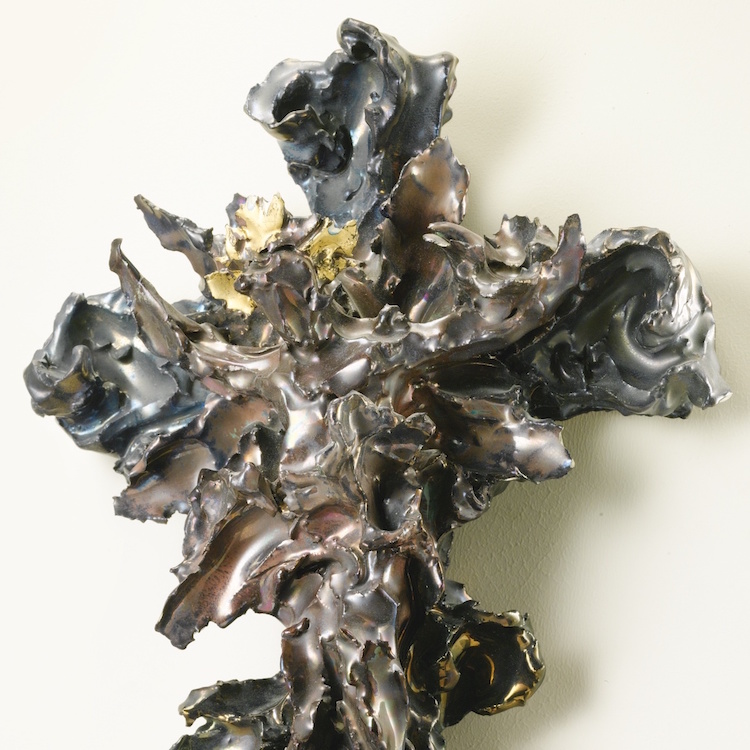PARIS — Several examples of late Italian sculptor Lucio Fontana‘s twisted and askew ceramic crosses and crucifixes are on exhibition in Crosses at Galerie Karsten Greve (May 20 – July 29, 2017). Hyperallergic writes, Fontana’s crosses “[evoke] hallucinogenic transmutation and transubstantiation.”
Made between 1948 and 1961 — and thus predecessors of quasi-religious acid art — their woozy motifs reek of the high “sacramental vision” that Aldous Huxley discovered under the influence of mescaline, as recounted in his book ‘The Doors of Perception.’
The problems of describing LSD’s effects are notorious, and the typology of its consequences vary, but Fontana’s crosses display the central, salient acid experience.
Featured Image: Lucio Fontana, Crocifisso (detail), 1948, Polychrome ceramics, 42 x 27 x 11.5 cm.

Lucio Fontana, Crocifisso, 1948, Polychrome ceramics, 42 x 27 x 11,5 cm. Click for larger image
Fontana’s substantial occupation in religious sculptures, however, became overshadowed during the outset and development of the Spatialist adventure of slashed canvases and spatial environments, the gallery writes.
These became his primary occupation for more than ten years until the end of the 1950s, or, in other words: exactly contemporaneously to the development of Spatialism and Concetti Spaziali (Spatial Concepts) and Ambienti spaziali (Spatial Environments) that for a long time contributed to his renown, thus eclipsing his religious ceramics.

Lucio Fontana, Crocifisso, 1955-57, Polychrome ceramics, 43 x 35,5 x 11 cm. Click for larger image
Even so, Fontana didn’t necessarily identify as a devout artist, rather, his works drew upon his childhood growing up in his father’s studio in Rosario de Santa Fe, Argentina sculpting funeral monuments, Christs and the Virgin and Child. The gallery writes, Fontana, liberated from any restrictive ties to the material, applied his aesthetic freedom to this childhood experience yielding mythical conduits that give rise to new artistic inventiveness that venerates gesture, matter, space, color and light.
Working with clay, and therefore with ceramic, allows him to express, in a very ‘sketch-like’ fashion, both the great ductility in one continuous movement (a spatial continuum), as well as the energy in his hand gestures that demonstrate the spontaneity and speed in his great artistic virtuosity. Art critic and friend Guido Ballo (1914-2010) remembered that when he was sculpting, “his hands created an aerial musicality and he remained silent as though in a trance.”
Fontana searches in all directions. He is curious, inventive, highly productive, and when a method crosses his path, he seizes the opportunity: he unhesitatingly updates those from the past to bring them into step with his own era, thus showing that he is indeed a man with a plethora of aesthetics.

Lucio Fontana, Crocifisso, 1950-55, Polychrome ceramics, 36 x 19,5 x 12 cm

Lucio Fontana, Crocifisso, 1961, Polychrome ceramics, 39,5 x 21 cm
Recommended Reading: We really like this write-up from Joseph Nechvatal of Hyperallergic.
Images: © Fondazione Lucio Fontana, by SIAE 2017, Courtesy Galerie Karsten Greve Cologne/Paris/St Moritz
Do you love or loathe these Crosses from the worlds of contemporary ceramic art and contemporary ceramics? Let us know in the comments.

Cover: Lucio Fontana, Deposizione della Croce, 1959-60, Polychrome ceramics, 53 x 35 cm

Text: Lucio Fontana, Crocifissione, c. 1954, Ceramics, polychrome, 73 x 37 x 10 cm


Add your valued opinion to this post.